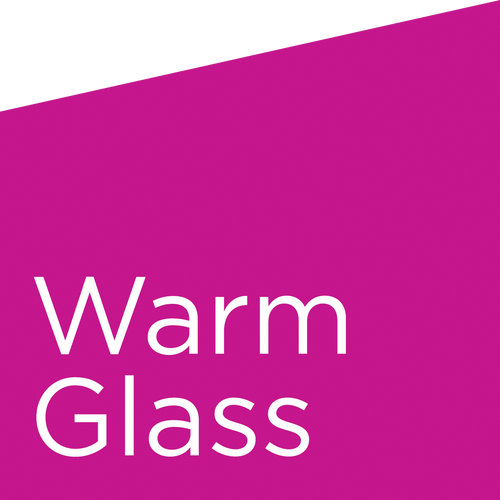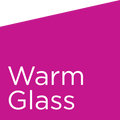About Dichroic Glass

About Dichroic Glass
Dichroic glass is excellent for creative glass fusing due to its strong colour and iridescent qualities, changing colour in different light. It is particularly popular in glass jewellery making.
'Dichroic' literally translates as 'two-coloured'. Dichroic glass has a transmitted colour and a completely different reflective colour; these two colours shift depending on the angle of view. This play of light together with its vibrant colour is what makes dichroic glass so prized by kiln glass artists.
The dichroic element is actually a very thin, multi-layer coating placed onto the glass surface. This is done using a technical process known as thin film coating. It was originally created for the aerospace industry, but its applications in the art world were quickly appreciated. Here at Warm Glass UK we sell dichroic that is coated onto Bullseye compatible glass (CoE90), usually 2mm black or clear glass. Once fired, the coating is bonded permanently to the glass surface. It can be fired between layers or as a capping glass depending on the result you are looking for.
CBS have been manufacturing this product longer than anyone in the business and their dichroic glass is Bullseye compatible and of consistently high quality.
Benefits of dichroic glass:
Bullseye compatible dichroic - All dichroic we sell is tested as Bullseye compatible, CoE90, so can be fused with Bullseye Glass.
Iridescence - Nothing beats dichroic for stunning iridescent visual effect. More impact than Bullseye non-dichroic iridescent styles.
Simple, with great results - Dichroic is a fantastic gateway into glass fusing. It is easy to get great results, and you can make stunning jewellery in the smallest of kilns. Try our cabochon kit to get started.
Depth through layering - layering up different dichroic creates fabulous depth and interest in any piece. Take a look at our Making Dichroic Glass Jewellery tipsheet.
Vast range - We stock a huge range of styles on both black and clear Bullseye glass so there are no limits to your creativity.
Accessory glass - Explore this medium further with dichroic frit, extract, flakes, stringers, firestix and more, or experiment with our economy packs to find new favourites.
Frequently asked questions:
What exactly is dichroic glass?
The glass in dichroic glass is standard fusing glass, it is the coating on top that makes it so special.
A multi-layer coating is placed on glass by using a highly technical vacuum deposition process. Quartz Crystal and Metal Oxides are vaporised onto the surface of the glass in the form of a crystal structure. Dichroic Colours have as many as 30 layers of these materials yet the thickness of the total coating is approximately 35 millionths of an inch. The coating that is created is very similar to a gemstone and by careful control in thickness, different colours are obtained. Thus, all dichroic coatings are created using the same exact materials.
Originally created for the Aerospace industry, dichroic glass is now made available to the artist community by Warm Glass UK in association with Coatings by Sandberg (CBS). The main characteristic of dichroic glass is that it has a transmitted colour (where light passes through the glass) and a completely different reflective colour (where light reflects off the glass). Furthermore, these two colours shift depending on angle of view. With the play of light, together with its vibrant colour, Dichroic Glass is a prime tool used to add interest to any piece of work or project. With over 300 Dichroic products available from Warm Glass UK, artists have unlimited freedom of expression.
What applications can dichroic glass be used for?
Warm Glass UK supplies only quality dichroic glass, manufactured by Coatings by Sandberg (CBS). CBS Dichroic Coatings are specifically designed to be hot worked. e.g. glass blowing, flame working, kiln-forming, slumping, bead making, and any other technique that involves the manipulation of glass with extreme heat.
While many artists use dichroic to produce jewellery and artwork, there is an ever growing demand for the use of dichroic glass in architecture. Its resilience to weather and never-fading colours are prime material to enhance office buildings, custom homes, walkways, fountains, skylights, walls, lighting fixtures and more.
What size is a quarter sheet of dichroic glass?
Dichroic Glass from CBS is coated in circles 48cm in diameter, a quarter sheet is a segment of that circle. CBS dichroic sheets are round to provide a constant uniform colour across the surface of the sheet during manufacture. Some sheets (usually the textures) will have an edge removed as the circle is cut from an original sheet which is less than 48cm wide by the manufacturers. The area of a quarter sheet is around 450 sqcm, which is about the same area as 4.5 10x10 cm sheets.

Why do the colours and finishes vary?
In most cases, dichroic glass is stable and fires in a similar way each time. However, because the colour is created by the separation of light waves by 30 layers of metal oxide coating, there can be variations in both colour and texture of fired pieces. Variations are most noticeable when the coating crystallises differently on the surface of the glass, causing it to be either very smooth or very rough. CBS dichroic usually crystallises to a matt finish. Generally, if you want a more matt finish to your piece, fire with the dichroic layer on top. For a smooth, glasslike finish, fire with the coating between glass layers. Never fire with two dichroic surfaces facing each other.
What do the colour names mean?
Each colour has a transmission colour (this is the colour you can see through the glass if the coating is on clear glass) and a reflected colour (this is the colour you see when the light bounces off of the surface of the glass). For example "Blue/Gold" will be blue in transmission and gold in reflection. If a black/opaque sheet is Blue/Gold, you would only see its reflection of gold (yet, it is still called Blue/Gold). The reflected dichroic colours shift towards the cool end of the spectrum when they are fired. e.g. a Blue/Gold shifts to a lime green; the degree of shift depends on the kiln firing.
How can I tell which is the coated side?
The coated side can be seen when you hold the glass at an angle to the light, if you see the colour run to the edge, then you are looking at the coated side, if you can see the depth of the glass with the coating below, you are looking at the non-coated side. Coatings should not normally be fused facing each other but interesting effects can be produced by using dichroic face up, covered, or stacked in multiple layers.
What is dichroic frit?
We supply dichroic coated frit in CoE90 Bullseye compatible glass. This product is not broken up sheets of glass, but actually coated frit. After extensive research CBS has designed a proprietary process that allows the frit to be coated on approximately 80% of the surface area of the glass. Due to this high ratio of coating versus glass, the dichroic frit responds very differently under heating/hotworking conditions, a must try for artists looking for a fresh or different look to their work. Try it in a jewellery casting mould.
Do I need special firing schedule to use dichroic glass?
The dichroic coating does not change the CoE or integrity of the glass in any way, so our standard Bullseye fusing schedules will work in most cases, unless another is specifically recommended in the product description. As with all things glass related, experimentation is key.
Is there a special way to cut dichroic Glass?
We recommend that you cut/score the glass on the uncoated side of the glass. This will produce a much smoother and cleaner break. Other than that the dichroic coating does not affect the integrity of the glass in any way.
Will the dichroic coating scratch?
Unfired dichroic can be scratched, as the coating is very thin. Fused dichroic is very strong and will not easily scratch.
Are some brands of dichroic glass better than others?
Some UK suppliers will say that there is no difference between the main dichroic producers. We believe that CBS Dichroic Glass is of superior quality, and our customer demand the best for the work they produce and sell. If you have been disappointed in the past with lower quality dichroic glass which foils, creeps or burns out, try ours. Our main supplier, CBS, is a family owned company and Jerry Sandberg, its founder, has been producing and supplying dichroic glass to the art community for well over 25 years.







